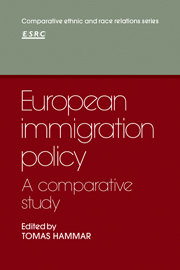6 - Federal Republic of Germany
Published online by Cambridge University Press: 05 November 2011
Summary
Immigration and immigration policy
In many respects the present situation in Germany in regard to immigration and immigrants is unprecedented. A great number of immigrant families are preparing for a permanent stay and some form of “integration”; moreover, easing the tension between integration and cultural autonomy is being considered on a political level. The situation now differs fundamentally from that of the past, when foreign workers were either clearly defined as seasonal workers and subjected to rigid Germanization during their stay (and in the Second World War forced into war production) or else used as an easily transferable labor pool to compensate for manpower shortages in certain branches of the economy. Yet policymakers have found it difficult to grasp this difference and to act accordingly, which is why the current reorientation of immigration policy has been so difficult.
To understand the novelty of the present situation and to appreciate the obstacles faced in changing from a “guestworker” policy to an “immigration” policy, one must begin by examining the varied history of population movements and foreign labor migration into the German Reich and the Federal Republic of Germany (FRG).
Until 1885 Germany was mainly an emigration country (Armengand 1971:163fT). Germans emigrated primarily to the United States and, to a lesser extent, to Canada, Australia, and South America. A number of Germans settled down to work as administrators and merchants or founded new settlements in the Baltic, Poland, and Russia.
- Type
- Chapter
- Information
- European Immigration PolicyA Comparative Study, pp. 165 - 205Publisher: Cambridge University PressPrint publication year: 1985
- 22
- Cited by



